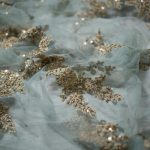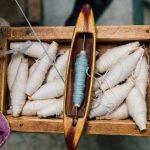When you're considering fabric options, it's important to understand the difference between silk and synthetic gossamer. Silk, derived from silkworms, boasts a natural elegance and breathability, while synthetic gossamer, made from polymers, offers durability and practicality. You might find yourself wondering which fabric better suits your needs, whether it's for an elegant occasion or daily wear. As you explore the characteristics and ideal uses of each fabric, you'll uncover insights that could influence your next purchase. So, what does each option bring to the table?
Table of Contents
Characteristics of Silk Gossamer
Silk gossamer is known for its luxurious smoothness and natural sheen, making it a sought-after material in high-quality textiles. When you touch silk gossamer, you immediately notice its soft, delicate texture that feels incredible against your skin. This lightweight fabric isn't only gentle but also incredibly strong, allowing for durability without sacrificing elegance. You may appreciate that silk gossamer has a natural breathability, helping regulate temperature and wick away moisture, making it comfortable to wear in various climates.
Another characteristic of silk gossamer is its vibrant color retention. When dyed, silk fibers absorb colors beautifully, giving you rich, deep hues that remain vibrant over time. Plus, the way silk drapes creates an enchanting flow, adding an ethereal quality to your garments. You might also notice how silk gossamer has a natural luster, reflecting light in a way that enhances its aesthetic appeal.
Additionally, silk gossamer is hypoallergenic, making it a safe choice for sensitive skin. These unique features contribute to its highest demand in fashion, home décor, and luxury items, allowing you to enjoy its timeless beauty and elegance.
Characteristics of Synthetic Gossamer
Synthetic gossamer boasts a sleek, lightweight feel that mimics the delicate texture of silk while offering enhanced durability and easy maintenance. You'll appreciate how this material stands up to wear, making it ideal for various applications, from clothing to home décor. Its resistance to wrinkles means you won't have to spend much time ironing or steaming, allowing you to enjoy this fabric without added fuss.
Moreover, synthetic gossamer often comes in a wide range of colors and patterns, giving you the versatility to choose something that fits your style and purpose. Its ability to repel moisture is another significant advantage, helping you avoid stains and maintain that crisp look you desire. When you wash synthetic gossamer, it dries quickly, which is perfect for busy lives.
You'll also find that synthetic gossamer is less prone to fading than silk, ensuring your garments and textiles retain their original vibrancy longer. Plus, it's a more economical choice, providing you with a budget-friendly option without sacrificing the luxurious appearance you're after.
Production Processes Comparison
When comparing the production processes of silk and synthetic gossamer, you'll notice significant differences that affect their quality, sustainability, and overall cost.
Silk Production: Silk comes from the cocoons of silkworms, primarily the mulberry silkworm. Farmers raise these worms, harvest the cocoons, and then carefully unwind the silk filaments. This labor-intensive process contributes to silk's luxurious appeal but also makes it expensive.
Synthetic Gossamer Production: In contrast, synthetic gossamer is produced from chemical processes involving polymers like nylon or polyester. Manufacturers create a mixture, extrude it into thin threads, and then weave or knit those threads into fabric. This method is typically faster and less costly.
Environmental Impact: The environmental footprint varies drastically; silk production has sustainable attributes as it utilizes natural resources, while synthetic gossamer relies on petroleum-based products, leading to greater ecological concerns.
Understanding these differences in production processes can help you choose the right fabric for your needs while considering ethical and environmental factors.
Ideal Uses for Each Fabric
Choosing the right fabric for your project depends on the unique qualities of each type, as they excel in different applications.
Silk gossamer, known for its luxurious feel and sheen, is ideal for garments like evening wear or delicate blouses. Its natural drape makes it perfect for creating flowing, elegant designs that catch the eye. You'll find silk perfect for high-end fashion or special occasions where comfort and aesthetics are priorities.
On the other hand, synthetic gossamer is often more durable and resistant to wear and tear. It's an excellent choice for outdoor gear, such as lightweight jackets or packable raincoats. Its affordability and easy care make it suitable for everyday apparel and activewear, allowing you to enjoy both comfort and functionality. If you're working on crafting projects that require a blend of strength and lightness, synthetic gossamer can also be a smart alternative.
Ultimately, consider your project's purpose and the qualities of each fabric. Whether you choose silk for its elegance or synthetic gossamer for its practicality, understanding their ideal uses helps you make the best selection for your needs.
Environmental Impact and Sustainability
Considering the growing concern for environmental sustainability, the differences in the production and disposal of silk and synthetic gossamer play a crucial role in your fabric choice.
Silk is a natural fiber, derived from silkworms, and while it's biodegradable, the farming practices can entail heavy pesticide use and significant water consumption. In contrast, synthetic gossamer, often made from petroleum-based materials, generally has a larger carbon footprint during production and can take hundreds of years to decompose.
Here are three key factors to consider:
- Resource Use: Silk farming relies on mulberry cultivation, which can lead to deforestation and water depletion. Synthetic gossamer, on the other hand, uses non-renewable resources, impacting fossil fuel consumption.
- Ecosystem Impact: The production of silk can harm local ecosystems, while the manufacture of synthetic fibers contributes to plastic pollution, particularly in oceans.
- Biodegradability: As a natural fiber, silk decomposes more readily than synthetic gossamer, which can linger in landfills and contribute to environmental issues.
Frequently Asked Questions
How Does the Cost of Silk Gossamer Compare to Synthetic Gossamer?
When you compare costs, silk gossamer tends to be more expensive due to its natural origins and manufacturing process. Synthetic gossamer is generally cheaper, offering a budget-friendly option without compromising too much on quality.
Can Silk Gossamer Be Safely Washed in a Washing Machine?
You shouldn't wash silk gossamer in a washing machine. It's delicate and can get damaged. Instead, hand wash it gently with cold water and a mild detergent to keep it looking beautiful and intact.
Are There Allergic Reactions Associated With Synthetic Gossamer?
Yes, you can experience allergic reactions to synthetic gossamer. These reactions might include skin irritation or respiratory issues. It's essential to monitor your body's response if you come into contact with synthetic materials.
What Are the Care Instructions for Silk Gossamer Items?
When caring for silk gossamer items, hand wash them in cold water using a gentle detergent. Avoid wringing, and instead lay them flat to dry, keeping them away from direct sunlight to maintain their quality.
Do Either Types of Gossamer Fade Over Time?
Yes, both types of gossamer can fade over time. Sunlight exposure and improper storage might accelerate fading, so keep your items away from direct sunlight and store them in a cool, dark place to prolong their vibrancy.
- Jaclyn Smith Fabric Coconut: a Review of This Rayon/Polyester Blend - June 29, 2025
- Jaclyn Smith Fabric Coconut: a Review of This Rayon/Polyester Blend - June 29, 2025
- How to Get Coconut Oil off Fabric Without Washing - June 29, 2025







